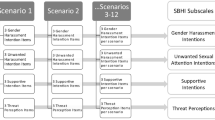Abstract
A 25-item self-disclosure questionnaire with items scaled for intimacy level was given to 32 male and 32 female college students. It was hypothesized that males would report disclosing less than females concerning intimate topics while there would be no sex differences in disclosure on nonintimate topics. The hypothesis was supported by the data. The results demonstrate that scoring self-disclosure scales by summing across all items can mask sex differences in disclosure patterns. Results are interpreted as supporting the assertions of several theorists that males reveal less personal information about themselves than do females.
Similar content being viewed by others
References
Balswick, J., & Peek, C. The inexpressive male: A tragedy of American society. Family Coordinator, 1971, 20, 363–368.
Bridge, R. G. Methodological issues in self-disclosure research: “Would you like being a prostitute: Why or why not.” Paper read at Western Psychological Association, 1973.
Cozby, P. Self-disclosure: A literature review. Psychological Bulletin, 1973, 79, 73–91.
Farrell, W. The liberated man. New York: Random House, 1974.
Fasteau, M. F. The male machine. New York: McGraw-Hill, 1974.
Hartley, R. Sex role pressures in the socialization of the male child. Psychological Reports, 1959, 5, 457–468.
Jourard, S. Self-disclosure in British and American college females. Journal of Social Psychology, 1961, 54, 315–320.
Jourard, S. Self-disclosure: An experimental analysis of the transparent self. New York: Wiley, 1971. (a)
Jourard, S. The transparent self (rev. ed.). New York: Van Nostrand, 1971. (b)
Jourard, S., & Lasakow, P. Some factors in self-disclosure. Journal of Abnormal and Social Psychology, 1958, 56, 91–98.
Jourard, S., & Resnick, J. L. The effect of high revealing subjects on the self-disclosure of low revealing subjects. Journal of Humanistic Psychology, 1970, 10, 84–93.
Parsons, T., & Bales, R. F. Family, socialization, and interaction process. Glencoe: Free Press, 1955.
Taylor, D. A., & Altman, I. Intimacy-scaled stimuli for use in studies of interpersonal relations. Psychological Reports, 1966, 19, 729–730.
Tuckman, B. Interpersonal probing and revealing and systems of integrative complexity. Journal of Personality and Social Psychology, 1966, 3, 655–664.
Author information
Authors and Affiliations
Rights and permissions
About this article
Cite this article
Morgan, B.S. Intimacy of disclosure topics and sex differences in self-disclosure. Sex Roles 2, 161–166 (1976). https://doi.org/10.1007/BF00287248
Issue Date:
DOI: https://doi.org/10.1007/BF00287248



